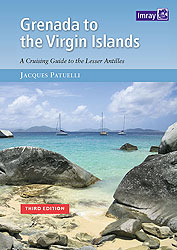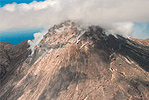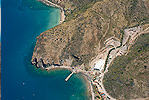| |
|

in 1493. It reminded him of the
countryside around the Catalan
monastery of Montserrat, so he named
the island after it. From 1632 the island
became the refuge of Irish Catholics
suffering from English persecution during
Cromwell’s time. Given its strategic
position, it was one of the centres of the
struggles between the French and the
English during the 18th century. It
became definitively British following the
Treaty of Versailles in 1783. As with
Antigua, the brief French interludes have
left no trace, quite unlike the island’s Irish
past, which is echoed in some of the local
surnames of today’s descendants of
African slaves, as well as in some
traditions like the celebration of St
Patrick’s Day. Some people fancy that,
just as Catholicism has survived here,
there’s a trace of an Irish accent too.
These days, although Montserrat is still
a British colony, the island has a certain autonomy in that the Governor chooses a
Chief Minister from a legislative council
elected by universal suffrage.
The island’s volcanic soil is very fertile;
in the middle of the 17th century the
development of farming was encouraged,
particularly the growing of sugar cane.
With the abolition of slavery cane
growing rapidly declined. With a
diversification into cotton growing,
fishing and market gardening, the island
these days is all but self-sufficient.
As far as tourism is concerned
Montserrat’s green hills led to it being
called the ‘Emerald Isle’. The tranquil
and cool ambience of the countryside
attracted many British and Canadians to
the island. However, those first flowers
of a tourist trade were brutally nipped in
the bud by a succession of fearsome
hurricanes. Then, to deliver the coup de
grâce, Galway’s Soufrière erupted,
burying the entire S of the island (see
above). All the island’s everyday life and
government shifted entirely to the small
settlements in the N of the island,
principally Salem and St Peter’s. Now
that the land in the S, always the most
fertile, is lost, agriculture has all but
collapsed. The cataclysm caused almost
half the population to emigrate to
neighbouring islands, leaving less than
5,000 people behind.
|
|
|
|

Where to stay and what to see
It is once more possible to travel between
Montserrat and Antigua, either by ferry,
or by air from Gerald’s Airport which
has been open in the N of the island since
2005. The loveliest places in the S have
been destroyed, which means the
Bamboo Forest and the Great Alp Falls
are no more. All the same, the N part of
Montserrat has some beautiful spots, with the possibility of good walking
through the tropical greenery. Along the
road to Salem, the lovely green site of
Runaway Ghaut is a splendid place to
picnic. There’s a mineral water spring
here. According to the legend, which
you’ll hear from the local guide, if you
drink from it you’ll certainly come back
to Montserrat.
Tours are organised to the ‘Day Time
Entry Zone’. From the heights of
Garibaldi Hill you can see the huge
volcano that still belches out jets of steam
from its jagged dome. On its S side you’ll
see what looks like the aftermath of an
atomic bomb explosion running down to
the sea, from which the calcined ruins of
Plymouth poke out of the ashes. It’s a
desolate sight for those who knew the
little town with its coloured old colonial
houses.
In the N and NW of the island a few
simple hotel-restaurants are still open and
others have reopened after moving up
from the S.
In the N the coast has several fine
beaches of black sand, Rendezvous Bay
being the only one with white sand. The
seabed here, volcanic in origin, has
several fine dive sites. To these meagre
attractions the Montserratians add their
own warm welcome to tourists in order
to continue to rebuild their economy
while the volcano is semi-dormant.
|
|
|







